The Amazing Akhenaten
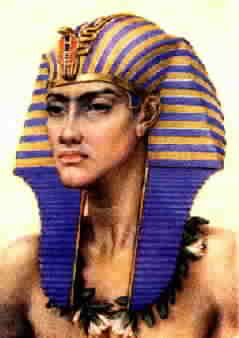
The pharoah that believed in ONE GOD was Akhenaten.
Akhenaten (often alt: Akhnaten, or rarely Ikhnaton) meaning 'Effective spirit of Aten', first known as Amenhotep IV (sometimes read as Amenophis IV and meaning 'Amun is Satisfied') before his first year (died 1336 BC or 1334 BC), was a Pharaoh of the Eighteenth dynasty of Egypt. He is especially noted for attempting to compel the Egyptian population in the monotheistic worship of Aten, although there are doubts as to how successful he was at this.
He was born to Amenhotep III and his Chief Queen Tiye and was their younger son. Akhenaten was not originally designated as the successor to the throne until the untimely death of his older brother, Thutmose. Amenhotep IV succeeded his father after Amenhotep III's death at the end of his 38-year reign, possibly after a short coregency lasting between either 1 to 2 years. Suggested dates for Akhenaten's reign (subject to the debates surrounding Egyptian chronology) are from 1353 BC-1336 BC or 1351 BC1334 BC.
He was at first the Pharaoh Amenhotep IV. He changed this name after the first year of rule..
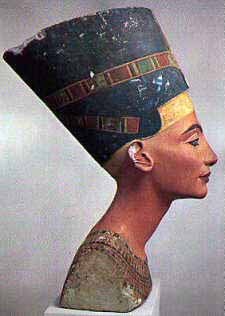 His wife Nefertiti was probably a distant relative. The Couple had six daughters named
Ankhesenpaaten, Neferneferuaten-tasharit, Neferneferure, Meketaten, Merytaten, and Sotepenre. Also
present in the family are two unknown members in Akhenaten’s family. They are Smenkhkare
(successor of Akhenaten) and Tutankhaten who was later renamed Tutankhamen.
His wife Nefertiti was probably a distant relative. The Couple had six daughters named
Ankhesenpaaten, Neferneferuaten-tasharit, Neferneferure, Meketaten, Merytaten, and Sotepenre. Also
present in the family are two unknown members in Akhenaten’s family. They are Smenkhkare
(successor of Akhenaten) and Tutankhaten who was later renamed Tutankhamen.
Solomon became friends with a 'Pharaoh' who became his father-in-law. I Kings:3:1 .. The queen, Solomons wife, had received as a gift from her father, the destroyed city of Gezer. Solomon rebuilt this city, and reintroduced scarbs, beads and Egyptian art. The art objects have been identifed with Amenhotep III, Queen Tiye and her son Ikhnaton. Ikhnaton ( also called Amenhotep IV ) who became pharoah Akhenaten, the controversial pharaoh who attempted to revive the worship of the sun god or Aten. After the reign of Amenhotep IV, no other pharaoh used that name.
"Akhenaten had to have a circle of loyal adherents who converted to his new religion. Friendly foreign princes were not particularly concerned with the change and accepted it as long as their relationships with the royal house were maintained. The king steadfastly forged ahead, trying to impose his new philosophies on Egyptian life. He succeeded in building temples to Aten in Thebes, Gem-Aton in Nubia, Heliopolis, Memphis, Hermopolis, Hermothis, and in some smaller cities".
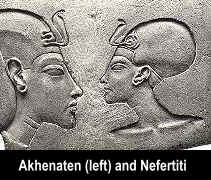 As most recall, Akhenaton moved the capitol
city to the middle of Egypt, to Tellu I-Amarna.
He only worshiped one God, the Sun God, Aten.
As most recall, Akhenaton moved the capitol
city to the middle of Egypt, to Tellu I-Amarna.
He only worshiped one God, the Sun God, Aten.
His reign was during the years, 1379 BC - 1362 BC. This was during the eighteenth dynasty. This dating clearly puts Ramesses II ( 1290-1224 BC ) on the throne long after Moses leaves Egypt.
“Khu-en-Aten (Akhenaten), the heretic king, rejected the Theban gods for the one-god (Aten) sun-worship of his foreign mother. He founded a new capital (now Tel-el-Amarna ruins), but neither capital nor religion long survived him.” It says here that Akhenaten got his religion from his mother. Much can be determined from the Egyptian statuary of Akhenaten and his mother, Queen Tiye. Akhenaten was so overpowering in Mongolian features, we don’t even have to guess what bloodline he and his mother were from. Akhenaten’s mother was considered a non-royal commoner, wife of Amenhotep III. Therefore, the only conclusion, which can be made, is that Akhenaten’s mother was one of the women, which were sent to Egypt by the Hurrians in the peace treaty Egypt made with them.
The Bible As History by Werner Keller, page 98 (pages vary in different editions) states: “In three successive generations of rulers Indo-Aryan (?) (Meaning Hurrians) and Egyptian blood was mixed for the first time.” This being true, Akhenaten and his relation were of the serpent (wisdom) seedline.
There are many pictures of Akhenaten in Egyptian books, so you won’t have any trouble identifying him as such. A picture is worth a thousand words. We can trust these portrayals and sculptures, for they were developed in greater detail during the Akhenaten era than at any other time in Egyptian history. What you see is what you get! You can be very sure, if Akhenaten looked Mongolian, he was indeed Mongolian.
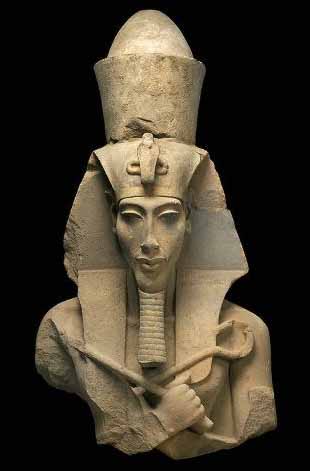 “The son of Amenhotep III and Tiye was the greatest eccentric in Egyptian
history, the heretic who, by changing his name from Amenhotep to Akhenaten,
incorporated into his new title the Aten that his grandfather had honored ... This
outstanding family, with its characteristically oval-shaped faces, large noses,
and insubstantial builds, presided over a renaissance of Egyptian power, a
transformation of Egyptian culture, and ironically, the first intimations (hint)
of final decline.” A further description of Akhenaten’s physical features is given on
page 65 as follows: “...his elongated head, heavy lips, large ears, distended stomach,
and wide hips — which were undoubtedly the end-product of generations of royal
inbreeding.” I would rather suggest “out breeding” with other races!
“The son of Amenhotep III and Tiye was the greatest eccentric in Egyptian
history, the heretic who, by changing his name from Amenhotep to Akhenaten,
incorporated into his new title the Aten that his grandfather had honored ... This
outstanding family, with its characteristically oval-shaped faces, large noses,
and insubstantial builds, presided over a renaissance of Egyptian power, a
transformation of Egyptian culture, and ironically, the first intimations (hint)
of final decline.” A further description of Akhenaten’s physical features is given on
page 65 as follows: “...his elongated head, heavy lips, large ears, distended stomach,
and wide hips — which were undoubtedly the end-product of generations of royal
inbreeding.” I would rather suggest “out breeding” with other races!
For more information in regards to this product of
Amenhotep III and Queen Tiye (the Hurrian), I will again quote from the book
The Pyramids And Sphinx by Desmond Stewart, page 64:
“The heir of Amenhotep III and Queen Tiye assumed the throne ... under his
father’s name, but then abruptly renamed himself Akhenaten. On the new
king’s orders the name of the god Amen Re was deleted from most monuments.
At the same time the pharaoh moved his residence from Thebes to a new,
hastily built capital some three hundred miles to the north.
The site, a half-moon-shaped plain on the east bank of the Nile, had been visited by Akhenaten’s grandfather Tuthmosis IV. The new capital, with its sunlit, open temple to the Aten, was an attempt at Utopia and was given the name Akhetaten, or Horizion-of-the-Aten. (The site’s modern name, Tell el-Amarna, comes from the names of two nearby Arab villages ... The city was not without an economic base, since all the river-borne transport headed north and east passed by it and could be milked to the disadvantage of rival Thebes.”
Under Amenhotep III ... the priesthood of Ammon (Amen) at Thebes had grown dangerously powerful. On his death his widow, Queen Tiyi (Tiye), a remarkable woman of non-royal birth, encouraged her twelve-year-old son, now Amenhotep IV, (later to become known as Akhenaten), to give precedence to the sun god Ra who after being paramount in earlier times had now been ousted by Ammon.
The boy king accordingly erected a temple at Thebes to Ra, under the form of Aton (or Aten), ‘the Sun’s Disk’, by which he intended to symbolize the deity behind the sun who gives heat and life to the world. He thus at one sweep superseded the worship of Ammon, and with it that of the whole Egyptian pantheon, substituting an ideal monotheism. Finding it impossible to make any headway in the stronghold of Ammon himself he decided, no doubt with his mother’s support, on the bold plan of changing his capital.”
“So he sailed downstream some 250 miles and founded a new city on a virgin site ‘belonging to no god or goddess, no prince or princess, and of which no man could claim ownership.’ At the same time, as an outward sign of his complete break with the old polytheism, he changed his name from Amenhotep, ‘Ammon is at rest’, to Akhn-aton’, ‘the Aton is satisfied’ ... Here he erected the temple to the Aton, 250 feet square, within an oblong enclosure half a mile in length. Close by were the palace buildings, covering a space of 1,500 by 500 feet.”
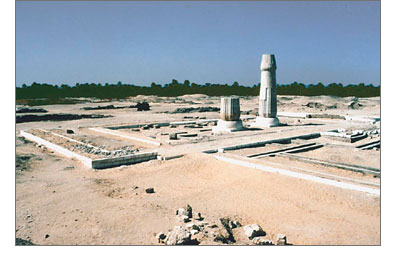
Tel-Amarna - A Site of a city, located about 280km south of Cairo in Middle Egypt, opposite the modern town of Deir Mawas. Originally named Akhetaten, and founded by the pharaoh Akhenaten (1352-1336 BC) the site is now known as Tell el-Amarna.
Akhet-Aten was built very quickly, using sun-dried mud brick rather than stone in most capacities. The archaeologists often comment in their reports about the shabby construction work hidden beneath the white-washed and often painted walls of the city buildings. The city was demolished and defaced by the Egyptians after Akhenaten's reign ended. For these reasons little remains of the site today, even though it was occupied for only a decade or two. However, from aerial photos you can still clearly read the lines of the walls of buildings. Currently teams are working under the direction of Barry Kemp of the EES in Amarna, reconstructing and studying the ruins.
Though Akhet-Aten was occupied for only a handful of years by the Egyptians, there have also been monastic settlements and roman camps, and part of the site is still unexcavated beneath modern cultivation closer to the nile.
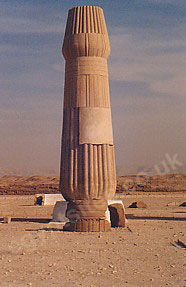 Akhenaten choose to move there in his fourth year as
Pharaoh, soon carving beautiful boundary stelae into the
cliffs around the city, attributing the choice of the site
to the Aten. Many of these stelae have since been destroyed,
in at least one case by treasure-seekers trying to open the
"door" in the stone.
Akhenaten choose to move there in his fourth year as
Pharaoh, soon carving beautiful boundary stelae into the
cliffs around the city, attributing the choice of the site
to the Aten. Many of these stelae have since been destroyed,
in at least one case by treasure-seekers trying to open the
"door" in the stone.
Restored columns from the Small Aten Temple, known in antiquity as the Mansion of the Aten. It possibly served as a private sanctuary for the royal family. As you can see, 'pillers' are present in the ancient temple complex. Here once stood the House of the Aten, known today as Great Aten Temple. The temple proper measured some 750 meters (2500 feet) long and 230 meters (750 feet) wide. Offering tables crowded the interior and also occupied a vast area outside the temple walls.
It was occupied for approximately two decades before being abandoned. The stone monuments were largely broken up and reused by subsequent rulers. see a drawing of the temples of Aten
The city itself is divided into suburbs, with the so-called "central city" housing the Royal Palace and The Great Temple (The Per-Aten), as well as various buildings archaeologists have labelled official (police, taxes...). It is here in one such building, the 'records office' that the Amarna Letters were found by a peasant woman.
 Further south, the famous bust of Nefertiti was
discovered in Thutmose's workshop at Akhet-Aten.
Further south, the famous bust of Nefertiti was
discovered in Thutmose's workshop at Akhet-Aten.
To the east there is an interesting settlement dubbed "the workmen's village" - it is a walled enclosure of very regular houses along several parallel streets. Archaeologists believed it housed workers working on the rock tombs nearby (which, incidentally, though built for the royalty and courtiers, were never occupied). However, this walled town had a guard house at the only exit, and it seems more likely to have been to keep the workers in than anything out (the main city was protected by no such wall, for the whole site, including the workmen's village, is enclosed by high cliffs).
Akhetaten was abruptly abandoned following Akhenaten's death after an occupation of only 25-30 years, and it is for this reason that the ruins of el-Amarna are probably the best preserved example of an Egyptian settlement during the New Kingdom. The city included temples, palaces, and large areas of mud-brick housing, and archaeologists have been able to study these ruins and ground plans to see how an ancient city developed. The plundered and vandalised remains of the royal tombs of Akhenaten and his family were discovered several kilometers outside the city in the late 1880's.
Tell el-Amarna has been examined by a succession of excavators, including Flinders Petrie, Howard Carter and Leonard Woolley (Royal city of Ur).
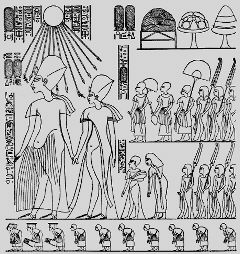 It is apparent from this inscription that Akhenaten and
Ankhkheperure were ruling together, and that Ankhkheperure was
married to Akhenaten's eldest daughter, Meritaten. But the most
curious thing about this inscription is that one of Ankhkheperure's
names is Neferneferuaten, also one of the names of Akhenaten's
Chief Wife, Nefertiti. Because of this, some people have come
to the conclusion that Akhenaten's coregent was none other than
Nefertiti herself, ruling under a different name in the guise
of a man. This seems extraordinarily unlikely -- would Nefertiti
impersonate a man and take on her own daughter as a spouse? And
yet, the throne name of King Ankhkheperure is occasionally written
in the feminine -- i. e., Ankhetkheperure, with the feminine
"t". William Murnane speculates that this indicates that King
Ankhkheperure Neferneferuaten was indeed Nefertiti, and a
separate individual from King Ankhkheperure Smenkhkare ...more
Akhenaten Art
It is apparent from this inscription that Akhenaten and
Ankhkheperure were ruling together, and that Ankhkheperure was
married to Akhenaten's eldest daughter, Meritaten. But the most
curious thing about this inscription is that one of Ankhkheperure's
names is Neferneferuaten, also one of the names of Akhenaten's
Chief Wife, Nefertiti. Because of this, some people have come
to the conclusion that Akhenaten's coregent was none other than
Nefertiti herself, ruling under a different name in the guise
of a man. This seems extraordinarily unlikely -- would Nefertiti
impersonate a man and take on her own daughter as a spouse? And
yet, the throne name of King Ankhkheperure is occasionally written
in the feminine -- i. e., Ankhetkheperure, with the feminine
"t". William Murnane speculates that this indicates that King
Ankhkheperure Neferneferuaten was indeed Nefertiti, and a
separate individual from King Ankhkheperure Smenkhkare ...more
Akhenaten Art
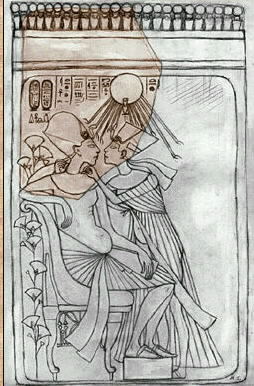 A fragmentary stela from Amarna, now known as the "Coregency
Stela," contains another puzzling bit of evidence. Originally,
the stela depicted three figures, identified as Akhenaten,
Nefertiti, and princess Meritaten. In later years, however,
the name of Nefertiti had been excised and replaced with the
name of King Ankhkheperure Neferneferuaten, and the name of
the princess had been replaced with that of Akhenaten and
Nefertiti's third daughter, Ankhesenpaaten. First, it is
curious that Nefertiti's figure -- clearly that of a female
-- would be relabled with the name of the king. Second, the
erasure of Meritaten's name and the usurpation by
Ankhesenpaaten suggests that Meritaten died before the
end of Akhenaten's reign, and that King Ankhkheperure
then married Ankhesenpaaten.
A fragmentary stela from Amarna, now known as the "Coregency
Stela," contains another puzzling bit of evidence. Originally,
the stela depicted three figures, identified as Akhenaten,
Nefertiti, and princess Meritaten. In later years, however,
the name of Nefertiti had been excised and replaced with the
name of King Ankhkheperure Neferneferuaten, and the name of
the princess had been replaced with that of Akhenaten and
Nefertiti's third daughter, Ankhesenpaaten. First, it is
curious that Nefertiti's figure -- clearly that of a female
-- would be relabled with the name of the king. Second, the
erasure of Meritaten's name and the usurpation by
Ankhesenpaaten suggests that Meritaten died before the
end of Akhenaten's reign, and that King Ankhkheperure
then married Ankhesenpaaten.
Little is known about the actual reign of King Ankhkheperure. Ankhkheperure Neferneferuaten reigned for at least three years, although it is not known how much of this time was spent in coregency with Akhenaten.
The Amarna Letters
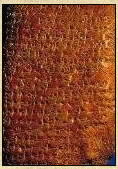 An Important cache of
documents from Tel-Amarna, discovered in 1887 by a village woman digging up
ancient mud-bricks for use as a fertiliser. There are 382 known clay cuneiform
tablets, most of which derive from the place of letters of Pharaoh
a building identified as the official records office.
An Important cache of
documents from Tel-Amarna, discovered in 1887 by a village woman digging up
ancient mud-bricks for use as a fertiliser. There are 382 known clay cuneiform
tablets, most of which derive from the place of letters of Pharaoh
a building identified as the official records office.
The exact chronology of these tablets is still debated, but they span a 15-30 year period beginning around the year of Amenhotep III (1390-1352 BC) and continuing through to no later than the first year of Tutankhamun's reign (1336-1327 BC), with the majority dating to the time of Akhenaten.
Most of these are now in European Museums (200 in Berlin, 80 in the British Museum and twenty at Oxford). They are written in cuneiform characters in the diplomatic language of the day, Akkadian..which originates in Sumer or the land of Ur.
They reflect the lively correspondence between the Egyptian administration and its representatives in Canaan and Amurru and the state of international affairs between Egypt and the major powers of the Middle East, Babylonia, Mitanni and Assyria, and the lesser countries such as Arzawa in western Anatolia.
Five cuneiform tablets were found naming Tushratta, a Mitanni king who was father-in-law to Amenhotep III and Akhenaten, another five from the Babylonian king Kadashman-Enlil and a few letters mentioning by name the Kassite king of Babylonia Burnaburiash, and the king of Arzawa.
Kings of major powers talked to the pharaoh as equals, calling him brother and often marrying a close relative to him. The pharaohs on the other hand never saw foreign kings as being quite their equals: no Egyptian royal was ever given in marriage to a foreign prince. The rulers of the Canaanite and Syrian towns under Egyptian sway on the other hand had to grovel before the pharaoh, figuratively in their letters - seven times and seven times, on the belly and on the back - and quite possibly literally when the pharaoh came their way. ...more about the Armana Letters
Of particular interest; a letter from Labayu
of Shechem to Akhenaten... exerpt; "Moreover, my crime is, so they
say, that I entered Gezer and said in public: " Will the king take my
property and not the property of Milkilu [ruler of Gezer]? " I know what
Milkilu has done against me. Moreover, the king wrote about my son. I did
not know that my son was associated to the Hapiru (Hebrew) [outlaws],
and I certainly would have put him into the hands of Addaya."
On The Widow's Son
page we discussed how Shechem was under the control of the Egyptians..This
confirms it... This looks like a conspiracy. We also discussed how we think
Joseph and Akhenaten were related, but could they have had the same
religious beliefs? No! Aten was a Sun God, the One God, while El 'Elyon was
worshipped by the peasant Hebrews. El 'Elyon is the god of storms and
war and is also known as Yehweh or Jehovah. El 'Elyon, as we have discovered,
was a false God. However as we shall see, there is an underlying secret to
this story. This letter is at
Shechem letter
The teachings of Amenemope were slowly losing their hold on the Egyptian mind when, through the influence of an Egyptian Salemite physician, a woman of the royal family espoused the Melchizedek teachings. This woman prevailed upon her son, Ikhnaton, Pharaoh of Egypt, to accept these doctrines of One God. This was Sobeknefru, Dragon Queen of Egypt 1785-82 BC...who is also discussed on the Widow's Son page.
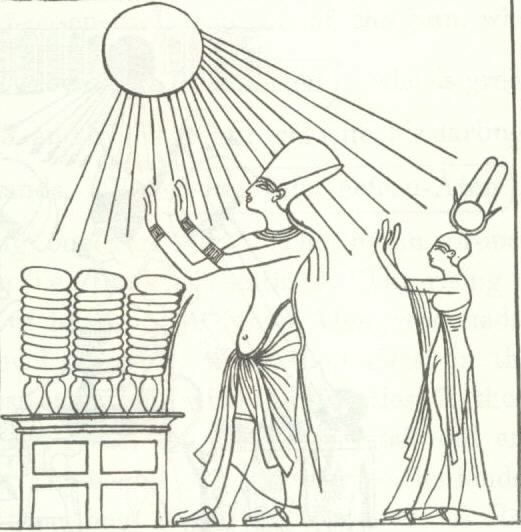 Since the disappearance of Melchizedek in the
flesh, no human being up to that time had possessed
such an amazingly clear concept of the revealed religion
of Salem as Ikhnaton. In some respects this young
Egyptian king is one of the most remarkable persons
in human history. During this time of increasing
spiritual depression in Mesopotamia, he kept alive
the doctrine of El Elyon, the One God, in Egypt,
thus maintaining the philosophic monotheistic channel
which was vital to the religious background of the
then future bestowal of Michael. And it was in
recognition of this exploit, among other reasons,
that the child Jesus was taken to Egypt, where some
of the spiritual successors of Ikhnaton saw him and
to some extent understood certain phases of his
divine mission to Urantia.
Since the disappearance of Melchizedek in the
flesh, no human being up to that time had possessed
such an amazingly clear concept of the revealed religion
of Salem as Ikhnaton. In some respects this young
Egyptian king is one of the most remarkable persons
in human history. During this time of increasing
spiritual depression in Mesopotamia, he kept alive
the doctrine of El Elyon, the One God, in Egypt,
thus maintaining the philosophic monotheistic channel
which was vital to the religious background of the
then future bestowal of Michael. And it was in
recognition of this exploit, among other reasons,
that the child Jesus was taken to Egypt, where some
of the spiritual successors of Ikhnaton saw him and
to some extent understood certain phases of his
divine mission to Urantia.
Moses, the greatest character between Melchizedek and Jesus, was the joint gift to the world of the Hebrew race and the Egyptian royal family; and had Ikhnaton possessed the versatility and ability of Moses, had he manifested a political genius to match his surprising religious leadership, then would Egypt have become the great monotheistic nation of that age; and if this had happened, it is barely possible that Jesus might have lived the greater portion of his mortal life in Egypt.
Never in all history did any king so methodically proceed to swing a whole nation from polytheism to monotheism as did this extraordinary Ikhnaton. With the most amazing determination this young ruler broke with the past, changed his name, abandoned his capital, built an entirely new city, and created a new art and literature for a whole people. But he went too fast; he built too much, more than could stand when he had gone. Again, he failed to provide for the material stability and prosperity of his people, all of which reacted unfavorably against his religious teachings when the subsequent floods of adversity and oppression swept over the Egyptians.
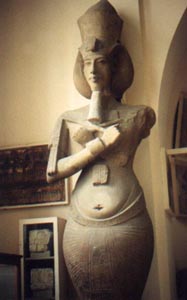 Had this man of amazingly clear vision and
extraordinary singleness of purpose had the political
sagacity of Moses, he would have changed the whole
history of the evolution of religion and the revelation
of truth in the Occidental world. During his lifetime
he was able to curb the activities of the priests,
whom he generally discredited, but they maintained
their cults in secret and sprang into action as soon
as the young king passed from power; and they were
not slow to connect all of Egypt's subsequent troubles
with the establishment of monotheism during his reign.
Had this man of amazingly clear vision and
extraordinary singleness of purpose had the political
sagacity of Moses, he would have changed the whole
history of the evolution of religion and the revelation
of truth in the Occidental world. During his lifetime
he was able to curb the activities of the priests,
whom he generally discredited, but they maintained
their cults in secret and sprang into action as soon
as the young king passed from power; and they were
not slow to connect all of Egypt's subsequent troubles
with the establishment of monotheism during his reign.
Very wisely Ikhnaton sought to establish monotheism under the guise of the sun-god. This decision to approach the worship of the Universal Father by absorbing all gods into the worship of the sun was due to the counsel of the Salemite physician. Ikhnaton took the generalized doctrines of the then existent Aton faith regarding the fatherhood and motherhood of Deity and created a religion which recognized an intimate worshipful relation between man and God.
Ikhnaton was wise enough to maintain the outward worship of Aton, the sun-god, while he led his associates in the disguised worship of the One God, creator of Aton and supreme Father of all. This young teacher-king was a prolific writer, being author of the exposition entitled "The One God," a book of thirty-one chapters, which the priests, when returned to power, utterly destroyed. Ikhnaton also wrote one hundred and thirty-seven hymns, twelve of which are now preserved in the Old Testament Book of Psalms, credited to Hebrew authorship.
The supreme word of Ikhnaton's religion in daily life was "righteousness," and he rapidly expanded the concept of right doing to embrace international as well as national ethics. This was a generation of amazing personal piety and was characterized by a genuine aspiration among the more intelligent men and women to find God and to know him. In those days social position or wealth gave no Egyptian any advantage in the eyes of the law. The family life of Egypt did much to preserve and augment moral culture and was the inspiration of the later superb family life of the Jews in Palestine.
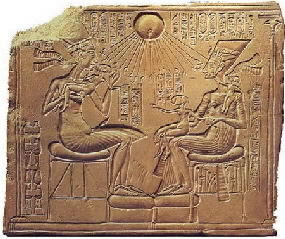 The fatal weakness of Ikhnaton's gospel was its
greatest truth, the teaching that Aton was not only
the creator of Egypt but also of the "whole world, man
and beasts, and all the foreign lands, even Syria and
Kush, besides this land of Egypt. He sets all in their
place and provides all with their needs." These concepts
of Deity were high and exalted, but they were not
nationalistic. Such sentiments of internationality
in religion failed to augment the morale of the Egyptian
army on the battlefield, while they provided effective
weapons for the priests to use against the young king
and his new religion. He had a Deity concept far above
that of the later Hebrews, but it was too advanced to
serve the purposes of a nation builder.
The fatal weakness of Ikhnaton's gospel was its
greatest truth, the teaching that Aton was not only
the creator of Egypt but also of the "whole world, man
and beasts, and all the foreign lands, even Syria and
Kush, besides this land of Egypt. He sets all in their
place and provides all with their needs." These concepts
of Deity were high and exalted, but they were not
nationalistic. Such sentiments of internationality
in religion failed to augment the morale of the Egyptian
army on the battlefield, while they provided effective
weapons for the priests to use against the young king
and his new religion. He had a Deity concept far above
that of the later Hebrews, but it was too advanced to
serve the purposes of a nation builder.
Though the monotheistic ideal suffered with the passing of Ikhnaton, the idea of one God persisted in the minds of many groups. The son-in-law of Ikhnaton went along with the priests, back to the worship of the old gods, changing his name to Tutankhamen. The capital returned to Thebes, and the priests waxed fat upon the land, eventually gaining possession of one seventh of all Egypt; and presently one of this same order of priests made bold to seize the crown.
But the priests could not fully overcome the monotheistic wave. Increasingly they were compelled to combine and hyphenate their gods; more and more the family of gods contracted. Ikhnaton had associated the flaming disk of the heavens with the creator God, and this idea continued to flame up in the hearts of men, even of the priests, long after the young reformer had passed on. Never did the concept of monotheism die out of the hearts of men in Egypt and in the world. It persisted even to the arrival of the Creator Son of that same divine Father, the one God whom Ikhnaton had so zealously proclaimed for the worship of all Egypt.
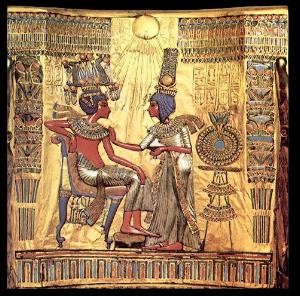 The weakness of Ikhnaton's doctrine lay in the
fact that he proposed such an advanced religion that
only the educated Egyptians could fully comprehend
his teachings. The rank and file of the agricultural
laborers never really grasped his gospel and were,
therefore, ready to return with the priests to the
old-time worship of Isis and her consort Osiris, who
was supposed to have been miraculously resurrected
from a cruel death at the hands of Set, the god of
darkness and evil.
The weakness of Ikhnaton's doctrine lay in the
fact that he proposed such an advanced religion that
only the educated Egyptians could fully comprehend
his teachings. The rank and file of the agricultural
laborers never really grasped his gospel and were,
therefore, ready to return with the priests to the
old-time worship of Isis and her consort Osiris, who
was supposed to have been miraculously resurrected
from a cruel death at the hands of Set, the god of
darkness and evil.
The teaching of immortality for all men was too advanced for the Egyptians. Only kings and the rich were promised a resurrection; therefore did they so carefully embalm and preserve their bodies in tombs against the day of judgment. But the democracy of salvation and resurrection as taught by Ikhnaton eventually prevailed, even to the extent that the Egyptians later believed in the survival of dumb animals.
Although the effort of this Egyptian ruler to impose the worship of one God upon his people appeared to fail, it should be recorded that the repercussions of his work persisted for centuries both in Palestine and Greece, and that Egypt thus became the agent for transmitting the combined evolutionary culture of the Nile and the revelatory religion of the Euphrates to all of the subsequent peoples of the Occident.
The glory of this great era of moral development and spiritual growth in the Nile valley was rapidly passing at about the time the national life of the Hebrews was beginning, and consequent upon their sojourn in Egypt these Bedouins carried away much of these teachings and perpetuated many of Ikhnaton's doctrines in their racial religion.
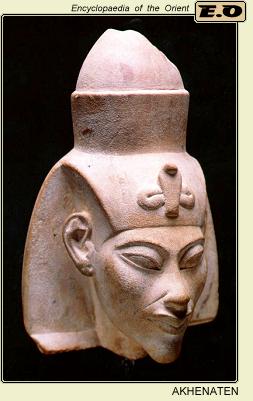 Most statutes depict Akhenaten as a woman,..."Others
believe that he was depicting himself as the
bisexual embodiment of the sun god, the mother and father of all mankind who
impregnated himself to create the universe".
He was infact depicting himself as the God who was both Mother
and Father. We have found several references
to God, dividing himself in two, making a wife or mate for himself ( Sophia, Isa, Zoe,
Isis ) who then is impregnated by him and
gives birth to mankind. This is also a symbolic representation of Adam, as his
rib becomes his mate and their offspring.
There is reference to a 'selected response' when he kisses her for
the first time. This then refers to the phallus symbol
considered to be pagan, vulgar and evil by later Christian writers.
It represents the first procreation of mankind.
The laws of Moses demanded that a King or any man who considered himself
a 'Son of God', by law had to marry and have at least two sons.
Even into the days of Jesus this law was carried out.
Most statutes depict Akhenaten as a woman,..."Others
believe that he was depicting himself as the
bisexual embodiment of the sun god, the mother and father of all mankind who
impregnated himself to create the universe".
He was infact depicting himself as the God who was both Mother
and Father. We have found several references
to God, dividing himself in two, making a wife or mate for himself ( Sophia, Isa, Zoe,
Isis ) who then is impregnated by him and
gives birth to mankind. This is also a symbolic representation of Adam, as his
rib becomes his mate and their offspring.
There is reference to a 'selected response' when he kisses her for
the first time. This then refers to the phallus symbol
considered to be pagan, vulgar and evil by later Christian writers.
It represents the first procreation of mankind.
The laws of Moses demanded that a King or any man who considered himself
a 'Son of God', by law had to marry and have at least two sons.
Even into the days of Jesus this law was carried out.
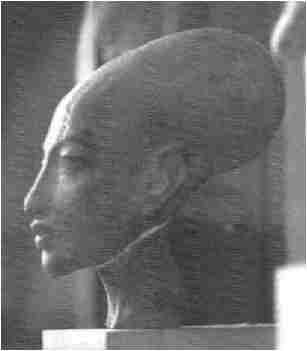 There were six female children
to Nefertiti and Aken-aten. Busts have been found of two of them.
Brain / skull flattening - becoming platycephalic (flattened),
sometimes allied to lengthened skulls (dolichocephalic) in Peruvian,
Egyptian, & Mayan rulers.
Unknown but apparently extensive mental changes -
[Research gives reasons for believing that elite mental changes
described above are results of a group aiming for perpetual 'dominance'
and thereby eventually giving up human 'self-consciousness'.
We speculate that the flattening of the fore-brain (platycephalic
skull), seemingly typical of elite evolution, is indicative of
the loss or atrophy of normal 'human' traits in elites -
before they finally become extinct.
There were six female children
to Nefertiti and Aken-aten. Busts have been found of two of them.
Brain / skull flattening - becoming platycephalic (flattened),
sometimes allied to lengthened skulls (dolichocephalic) in Peruvian,
Egyptian, & Mayan rulers.
Unknown but apparently extensive mental changes -
[Research gives reasons for believing that elite mental changes
described above are results of a group aiming for perpetual 'dominance'
and thereby eventually giving up human 'self-consciousness'.
We speculate that the flattening of the fore-brain (platycephalic
skull), seemingly typical of elite evolution, is indicative of
the loss or atrophy of normal 'human' traits in elites -
before they finally become extinct.
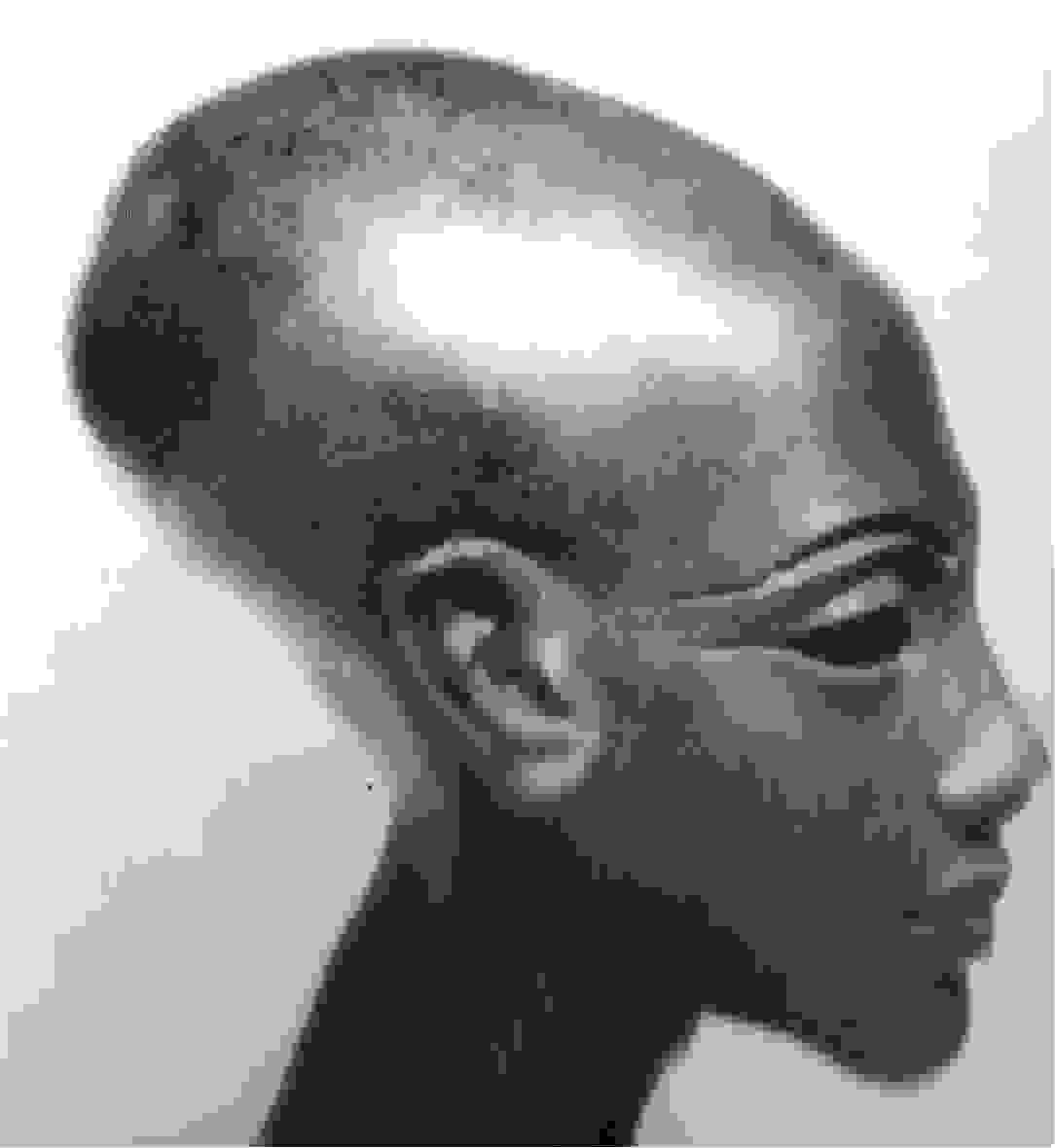 We know that sociability, kindness, social responsibility,
etc. are now known to have evolved associated with that area
of the normal human brain within the high forehead of modern homo. sap.
Later note - it seems that Native Americans had a tradition which
would tend to prevent authoritarianism and elitism. They
used 'cradle-boards' to flatten the back of the skull.
We know that sociability, kindness, social responsibility,
etc. are now known to have evolved associated with that area
of the normal human brain within the high forehead of modern homo. sap.
Later note - it seems that Native Americans had a tradition which
would tend to prevent authoritarianism and elitism. They
used 'cradle-boards' to flatten the back of the skull.
One bust (left) could be that of Meritaten, the eldest. The family traits are obvious.
QUOTE; "the [King's] profile is not only effeminate, it is also deformed. The legs, for instance, are fatty around the thighs but spindly below the knees." - UNQUOTE - Cairo Museum
In sculptures and paintings of Akhenaten, he is shown as having a long, slender neck, a long face with a sharp chin, narrow, almond-shaped eyes, full lips, long arms and fingers, rounded thighs and buttocks, a soft belly, and enlarged breasts. His odd appearance was particularly prominent in art from the early part of the reign. One early statue portrays the king in the nude and without genitalia of any kind.
These features have puzzled archaeologists since Akhenaten was first discovered in the early nineteenth century, and people have offered many explanations as to why he looked this way.
It is not likely that Akhenaten was a woman. The rumor that Akhenaten was a woman has no real basis and was started in an effort to explain Akhenaten’s strange physical characteristics as portrayed in sculptures and other forms of art. Akhenaten fathered children which is an impossible task for two women to undertake. Akhenaten was indeed portrayed with small breasts and feminine features; however, people liken his appearance more often to a genetic disease such as Froehlich's Syndrome or Marfan's Syndrome.see.. Research Akenhaten
The most popular belief is that Akhenaten suffered from Froehlich's Syndrome, an endocrine disorder found most commonly in men.
The endocrine system consists of the glands in the body which produce and release into the bloodstream certain chemicals known as hormones. Hormones regulate various bodily functions, like glucose and insulin levels in the blood, growth, salt metabolism, and sexuality.
The main endocrine gland is the pituitary, located in the forebrain. The pituitary gland is divided into two parts: the anterior pituitary, which regulates the activities of the other glands in the system and is also responsible for the release of growth hormone, and the posterior pituitary, which regulates water and salt metabolism. The pituitary is regulated in turn by the hypothalamus, which also regulates hunger and various other biological functions. (Weiten, W., 1995).
Froehlich's Syndrome can be caused by a variety things, the most common being a tumor in either the pituitary gland or the hypothalamus (Aldred, C. 1988, Pg. 232), (Brittanica, Vol. 5, 1992, Pg.19).
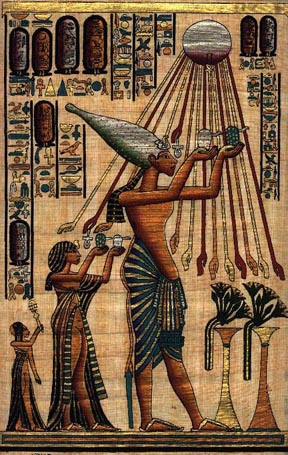 If Froehlich's Syndrome occurs as a tumor only in the pituitary gland, then it mainly seems to
affect the secondary sex characteristics in men. The secondary sex characteristics include body
hair and deepening of the voice. The reason that Froehlich's Sydrome causes this lack of
sexual development is that the gonads or sex glands (the testes, in men) don't function
properly as a result of the impaired functioning of the pituitary. Froehlich's Syndrome also
results in infertility, a lack of sex drive, and feminine fat distribution (Aldred, C. 1988, Pg. 232).
If Froehlich's Syndrome occurs as a tumor only in the pituitary gland, then it mainly seems to
affect the secondary sex characteristics in men. The secondary sex characteristics include body
hair and deepening of the voice. The reason that Froehlich's Sydrome causes this lack of
sexual development is that the gonads or sex glands (the testes, in men) don't function
properly as a result of the impaired functioning of the pituitary. Froehlich's Syndrome also
results in infertility, a lack of sex drive, and feminine fat distribution (Aldred, C. 1988, Pg. 232).
The most recently suggested possibility for Akhenaten's supposed pathology is a genetic disorder known as Marfan's Syndrome. This is a more likely possibility than Froehlich's Syndrome, as it does not affect intelligence or fertility (Burridge, A., 1995), (Redford, D., 1994).
Marfan's Syndrome was first described by a French doctor named Antione B. Marfan, who reported that some of his patients had especially long fingers (he called this arachnodactyly, or spider-fingers), skeletal abnormalities (including arms that were disproportionately long), and high, arched pallets. He also noticed spine defects (Wieczorek, Riegel, & Quattro, 1996).
Antione noted that these traits seemed to be inherited, and it is now certain that Marfan's Syndrome is a hereditary disease, and the gene for it is autosomal dominant (Wieczorek, Riegel, & Quattro, 1996).
A dominant gene is one that will overwrite other genes so that only one is required for the trait that that particular gene carries to be expressed. A person who inherits a dominant gene from one parent will automatically have the trait that the gene produces, unlike with recessive genes in which a gene for the trait must be inherited from each parent for the trait to show. Autosomal means that the gene is on a non-sex chromosome. There are 46 chromosomes in every human cell, and they make 23 pairs, each one connected by a centrome. The 23rd pair consists of the sex chromosomes (American Medical Association, 1993). The gene for Marfan's Syndrome is located on pair fifteen. This gene causes the occurrence of too many microfibrillar fibers in the connective tissue, which results in a lack of flexibility in the body's tissues (Wieczorek, Riegel, & Quattro, 1996).
Marfan's Syndrome almost always occurs as an inherited trait (about 75 to 85 percent of the time), but it can sometimes show up spontaneously in a person from a family that has never shown any signs of the disorder. Marfan's Syndrome, because it is dominant, will not skip generations (Wieczorek, Riegel, & Quattro, 1996). (A recessive gene can be passed on without showing up for many generations, because two are needed for the trait to show, but if a dominant gene is going to show up, it will do so right away.) Marfan's syndrome has a 50% chance of being passed on to the children of an affected person. If the gene for Marfan's Syndrome is passed on, it will invariably show up, but the degree to which it shows its symptoms varies considerably (Bruckheim, A. H., 1993).
Skeletal abnormalities that have been noticed in Marfan's patients are a long face, an unusually tall stature, a short upper body in comparison to the lower body (because they have a short ribcage), and overgrown ribs. The latter results in chest deformities such as Pectus Excavatum (funnel chest) or Pectus Carnatum (pigeon breast). A wide pelvis, elongated skull, and prominent shoulder blades are other symptoms (Burridge, A., 1995). One of the most distinctive characteristics of Marfan's Syndrome is unusually long arms, fingers, and toes. These skeletal problems can show up in either childhood or adolescence, and sometimes they do not show up at all (Wieczorek, Riegel, & Quattro, 1996). Extremely mobile joints are another common characteristic.
A good many victims have eye problems, like dislocated lenses, severe nearsightedness, iridodensis (a quivering motion of the iris), cataracts, detaching retinas, and glaucoma (Wieczorek, Riegel, & Quattro, 1996).
Because of the excessive fibers in the tissues of people with Marfan's Syndrome, their tissues often stretch to the point of breaking under the strain of normal tissue stress. There are often stretch marks on the skin, as a result of this. When this sort of stretching occurs in the aorta (the major artery that comes out of the heart), it can break, resulting in major complications (Wieczorek, Riegel, & Quattro, 1996). Because of the heart problems, people with Marfan's Syndrome usually have a short life-span, perhaps of about thirty years (Burridge, A., 1995). People with Marfan's Syndrome often suffer from various lung problems as well. Most patients show signs of emphysema, and 5% of the people with Marfan's Syndrome have problems with collapsed lungs (Bruckheim, A. H., 1993).
Muscle weakness may also occur (Bruckheim, A. H., 1993). This, along with the hypermobile joints, can result in accident proneness.
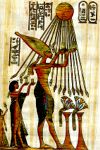 While Akhenaten led a reform on the Ancient Egyptian
religion, he also revolutionized Egyptian art. He broke the
conventions of Egyptian art by showing himself in warm family
scenes with his wife and children, and portraying himself and
the rest of the royal family in a much more human and
naturalistic manner than any of his predescessors had. The
most peculiar result of this art reform, however, was the
portrayal of the physical characteristics of the pharaoh himself.
While Akhenaten led a reform on the Ancient Egyptian
religion, he also revolutionized Egyptian art. He broke the
conventions of Egyptian art by showing himself in warm family
scenes with his wife and children, and portraying himself and
the rest of the royal family in a much more human and
naturalistic manner than any of his predescessors had. The
most peculiar result of this art reform, however, was the
portrayal of the physical characteristics of the pharaoh himself.
In sculptures and paintings of Akhenaten, he is shown as having a long, slender neck, a long face with a sharp chin, narrow, almond-shaped eyes, full lips, long arms and fingers, rounded thighs and buttocks, a soft belly, and enlarged breasts. His odd appearance was particularly prominent in art from the early part of the reign. One early statue portrays the king in the nude and without genitalia of any kind. see Genetics or Aesthetics?
The Emerald Tablets
This is the 'underlying secret' we mentioned eariler.
Although traditional history makes no mention of it, our hyper-history suggests that Akhenaten rediscovered the Emerald Tablet at the beginning of his rule as pharaoh. According to at least one ancient papyrus, without the writings of Thoth the larger pyramids could not be built, so a great search throughout Egypt was conducted until they were found. This may be the reason for the move to Tell Armana and the reason for the 'One God worship' of Aten. However we maintain that the Great Pyramid was build in 10,390 B.C. by the mathmetical genuis' of Atlantis. The Sphinx followed around 8500 B.C. and originally had the head of a lion.
Whether or not he found the tablet, Akhenaten stands as a candidate for the second Hermes because he tried to apply the tablet’s principles and spread its spirit throughout his reign. Known as the heretic pharaoh, he espoused the revolutionary concept of "living in truth" and acting in natural accord with cosmic principles that the tablet called the "Operation of the Sun." He referred to this universal ideal as Maat, which meant the "real thing" or absolute truth, the original will of the One Mind. The agent of Maat was the One Thing, of which the physical sun, or the solar Disk, was the physical expression. from.. #Akhenaten: the Second Hermes
One early Hellenistic papyrus known as 'An Invocation to Hermes' might refer directly to the Emerald Tablet and its author: "I know your names in the Egyptian tongue," it reads, "and your true name as it is written on the Holy Tablet in the holy place at Hermopolis, where you did have your birth."
That "true name" is the same name that all the Egyptian records point to as the author of the tablet: Hermes. But this person appears to have a threefold identity, which is why in the Latin translations of the tablet, he is called "Hermes Trismegistus" or "Hermes the Thrice Greatest." If we follow the strict genealogical order in the Egyptian texts, Hermes is the son of the Agathodaimon, the great Thoth, who is the Egyptian god of all learning and hidden knowledge. According to those same texts, Hermes himself had a son, Tat, who was a scribe and lived in Alexandria around 250 BC. As mundane as all this sounds, there is something very disconcerting about the triple progression here. It descends from god to god/man to common man.
Two links to translations of the Emerald Tablets are on The Legend of Hiram page. Plus deeper meanings of the 'Craft'. Please be sure you have read and understood the words in the Nag Hammid from the first Passage Page before you go there. You will see the connections and the full meanings emerge as if like 'magic'.
According to Exodus, Moses had fled to the land of the Kenites, which is what the subjects of Akhenaten were called. In the open court of the time, it can be assumed that Moses would have conferred with the pharaoh many times on behalf of his people. In Moses and Monotheism (1939), Sigmund Freud was the first to suggest that Moses appropriated the pharaoh’s idea of one supreme god and brought the new religion to the Jews. Perhaps all the legends linking Moses and tablet are not so far off.
Keeping in mind that the Kings and High Priests would have all been
'initiated' with all this knowledge in Egypt, this makes sence. Ezekiel wanted
this relationship destroyed. Did the rewrite of the Hebrew bible destroy
this evidence? Did they delibertly try to destroy Solomon too? The
relationship of Egypt to the Master Builders..
The Great Pyramid of Gaza or The Piller of Enoch
That brings us to the next order of ancient
religious traditions and symbols, those connected with Sabaism. Mackey says:
“The circle being a figure which returns into itself,
and having therefore neither beginning nor end, has been adopted
in the symbology of all countries and times as a symbol sometimes
of the universe and sometimes of eternity.”
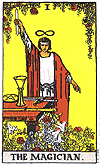 click the image for a larger picture of The Magician
click the image for a larger picture of The Magician
The circle, representing the disk of the sun with
radiating lines representing rays and these rays ending
with small representations of hands, was a symbol, in ancient Egypt, of the “one eternal
creative, fructifying and life-sustaining force.”
Of this, Savitri Devi says:
“Shu, as an ordinary noun, we must consider as heat, or heat and light,
for the word has these meanings. In the Pyramid Texts, Shu is the name
of a god symbolizing the heat radiating from the body
of Tem, or Tem-Ra, the creator of the solar disk in the indivisible trinity.
, Tem-Shu-Tefnut — father, son and daughter, the creator of the sun disk,
the heat and the moisture; the principle of fertility and its indispensable agents.
Whatever be therefore the interpretation we give to the word, whether we like it
as an ordinary, or as a proper noun, we have to admit that ‘the king deified
the heat of the sun, or the heat and light,’
as Sir Wallis Budge himself says, and worshipped it as the one eternal,
creative, fructifying and life-giving force. More about the 'magician' and other cards on
The Templars and The Secret Tarot Deck
“This permits us to assert, with Sir Flinders Petrie, that in the religion of the disk, the object of worship was ‘the radiant energy of the sun,’ of which heat and light are aspects.”
We have now connected the circle with perhaps the most important ancient religious symbol, the radiated circle or disk, which was the symbol of the world’s first monotheism, that of Amenhotep IV, or Akhenaten, who as Pharaoh of Egypt, 1375-1358 B.C., sacrificed a world empire and was doomed to oblivion by his priest-enemies in order to demonstrate the equality of all men, as being created by, therefore sons of, the one only god, Aten, whose symbol was the disk and whose creative principle was the radiant energy of the sun.
This should be particularly significant to all Freemasons,
for there can be no other possible grounds for the
brotherhood of all men than the monotheistic concept,
that they are the sons of the one and only God,
the Great Architect of the Universe. from the pages of
... ANCIENT RELIGIOUS TRADITIONS
"Circumambulation" is the name given by sacred archaeologists to that religious rite in the ancient initiations which consisted in a formal procession around the altar or other holy and consecrated object. The same rite exists in Freemasonry...
"The Rite of Circumambulation undoubtedly refers to the doctrine of sun-worship, because circumambulation was always around the sacred place, just as the sun was supposed to move around the earth; and although the dogma of sun-worship does not, of course, exist in Freemasonry, we find an allusion to it in the Rite of Circumambulation, which it preserves, as well as in the position of the officers of a Lodge and in the symbol of a point within a circle".
Dr. Oliver has a somewhat different interpretation of its meaning,
connecting it more directly with the manner of ancient sun worship. He writes:
“The ancients made it a constant practice to turn themselves round
when they worshiped the gods. By this circular motion, says Plutarch,
some imagine that they intended to imitate the motion of the earth.
But I am rather of the opinion that the precept is grounded on another notion that,
as all temples are built fronting the East,
the people, at their entrance, turned their backs to the sun
and, consequently, in order to fact the sun, they were obliged
to make a half-turn to the right and then, in order to place themselves before the
deity, they completed the round in offering up their prayers.”
Akhenaten found?
In 1907, an amateur Egyptologist named Theodore Davis led an expedition in the Valley of the Kings which uncovered a small tomb, now classified as King's Valley Tomb No. 55 (KV-55). The tomb had been badly damaged by water and robbers, and contained a confusing jumble of funerary equipment, including part of a small golden shrine belonging to queen Tiye, some magic bricks bearing the name of Akhenaten, a set of fine alabaster canopic jars which have been identified with numerous members of the Amarna family, and a beautiful multi-colored rishi (feathered)-type coffin with a badly damaged gold face.
The names had been hacked out of the coffin. Inside the coffin was a poorly preserved mummy, encased in gold foil, which fell apart when it was unwrapped. (Aldred, 1988; Davis et al., 1910) The gold shrine, the apparently female heads on the canopic jars, and the fact that the coffin seemed to depict a female figure, convinced Davis and his team that they had found the body of Queen Tiye, the mother of Akhenaten.
Davis and his team sent the bones to G. Elliot Smith, the Professor of Anatomy at Cairo School of Medicine. According to Smith, the gold mummy-bands that had encircled the mummy bore the name of Akhenaten (1912). However, according to Cyril Aldred, Arthur Weigall, one of the excavators of the tomb, reported that all the names that had once been on the bands had been hacked out (1988). The bands were stolen by Smith's laboratory assistants shortly after they were sent to him, so it is difficult to judge which account is correct. see Smenkhka
Smenkhkare: Ephemeral 18'th Dynasty king who ruled for only a few years after the death of Akhenaten. He was married to Meritaten, a daughter of Akhenaten and Nefertiti, and was probably an elder brother of Tutankhaten/Tutankhamen, who succeeded him on the throne. Click here for more biographical data on Smenkhkare. (This site has an artist's reconstruction of the KV 55 mummy's face.) Akhenaten? Smenkhkare
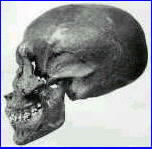 Details: Only a skeleton remains today of what has
proven to be the most controversial mummy ever found in Egypt.
Discovered by Edward Ayrton and Theodore M. Davis in January,
1907, the sole occupant of KV 55 was already badly damaged,
perhaps by water which had slowly dripped through a crack in
the tomb's ceiling during the occasional torrential floods
which scour the Valley of the Kings. The coffin in which
the mummy lay had once rested upon a wooden bier which,
according to Ayrton, had collapsed, dropping the coffin,
knocking the lid partly off, and displacing some of the
articles which had been laid on the mummy. (ToQT, 10 and
PSBA 29 [1907], 279.
Details: Only a skeleton remains today of what has
proven to be the most controversial mummy ever found in Egypt.
Discovered by Edward Ayrton and Theodore M. Davis in January,
1907, the sole occupant of KV 55 was already badly damaged,
perhaps by water which had slowly dripped through a crack in
the tomb's ceiling during the occasional torrential floods
which scour the Valley of the Kings. The coffin in which
the mummy lay had once rested upon a wooden bier which,
according to Ayrton, had collapsed, dropping the coffin,
knocking the lid partly off, and displacing some of the
articles which had been laid on the mummy. (ToQT, 10 and
PSBA 29 [1907], 279.
This was also Maspero's view, as recorded by J. L. Smith, TTAA, 60.) But as Bell pointed out, "The putative fall of the coffin due to the collapse of the 'rotted' bier is unproven." She further noted that it cannot be established with certainty that the lid of the coffin was not left ajar in ancient times, and believed that most of the damage to the coffin lid occurred when a section of the ceiling had fallen onto it, breaking it into three sections (JARCE 27 [1990], 133.)
To compound the ancient damage, Davis, eager to settle an argument with Arthur Weigall and Maspero concerning the mummy's identity, had the body hastily exposed in the tomb so that its gender could be determined by two visiting doctors from Luxor. Davis's account of the mummy's "examination," published in The Tomb of Queen Tiye (London [1910], 2), describes how one of the teeth of the mummy fell to dust when he touched it and relates that the bandages, rendered extremely fragile (supposedly by the water damage), were simply removed from the body piecemeal in the tomb itself.
American artist Joseph Lindon Smith, who Maspero nominated to remove the bandages, described them as crumbling to dust in the process: "No sooner had my hand touched the surface of the mummy than it crumbled into ashes...nothing remained except a pile of dust and disconnected bones..." (TTAA, 64.) Egyptologists today are dismayed by such hasty and careless methods, which destroyed more valuable historical evidence than they revealed.
Accounts concerning the mummy as it was first discovered are all vague and often contain inconsistencies. An examination of the published literature reveals several salient points about the mummy and the objects primarily associated with its burial. This information may be viewed by clicking on the following: Pectorial
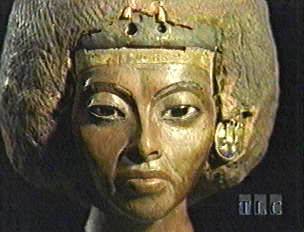 Along with the mummy and the objects discussed above,
KV 55 contained disassembled panels from a shrine (similar
to those found surrounding the sarcophagus of Tutankhamen)
that had been inscribed for Queen Tiye. Four calcite canopic
jars found in a large wall niche all had stoppers carved in
the likeness of a woman shown wearing a wig identical in
style to that which appeared on the coffin. [from EMC-87,
no. 171.]
Along with the mummy and the objects discussed above,
KV 55 contained disassembled panels from a shrine (similar
to those found surrounding the sarcophagus of Tutankhamen)
that had been inscribed for Queen Tiye. Four calcite canopic
jars found in a large wall niche all had stoppers carved in
the likeness of a woman shown wearing a wig identical in
style to that which appeared on the coffin. [from EMC-87,
no. 171.]
Additionally, Tiye's name (as well as that of her husband, Amenhotep III appeared on several of the smaller items scattered throughout the tomb (TTAA, 60.) Davis concluded that the mummy was that of Queen Tiye herself, and became infuriated when Weigall disagreed with this identification (and also when Maspero refused to take a side in the argument.) In order to prove his point, Davis called in a Dr. Pollock and an unidentified American obstetrician to examine the mummy and help determine its gender. (For Dr. Pollock's name, see Reeves, DRN, 44, and n. 170.) The doctors briefly examined the skeletal remains and pronounced them to be those of a woman. Feeling vindicated, Davis announced to the world that he had discovered the tomb of Queen Tiye.
Weigall, however, had noticed some things about the burial which Davis preferred to discount or ignore. The cartouches on the golden bands which he claimed were found around the mummy (JEA 8 [1922], 196-197) had all been neatly excised. The coffin and the shrine panels also had cartouches erased, and a scene on one of the panels depicted Queen Tiye facing another figure which had been completely obliterated. [from TVK, 215.])
From the context, it was easy to determine that this had been the figure of Akhenaten, the famous Heretic Pharaoh, who had been Queen Tiye's royal son, and whose name and image had been expunged from the official historical record by later rulers. Magical "bricks" of the sort normally placed at cardinal points in the walls of 18'th Dynasty tombs were found, and two of them bore the name of Akhenaten, another bit of evidence which, taken with the rest, convinced Weigall that the mummy was that of the Amarna King, cached in KV 55 after being removed from his original tomb at Akhetaten (JEA 8 [1922], 193ff.; C, [74: 5, Sept. 1907], 727-738.)
Akhenaten or Smenkhkare? When G. E. Smith finally examined the remains, he immediately recognized them to be the bones of a man, thereby effectively refuting Davis's theory that the mummy was that of Tiye. All subsequent examinations of the remains have supported this conclusion. Aldred believes that the two doctors who had first inspected the body in KV 55 had probably mistaken it as female because the bones of the pelvic region had been dislocated and then obscured in some fashion by the remains of the bandages and other debris when the coffin had fallen. (AKoE, 199.)
Smith, who accepted Weigall's identification of the mummy as Akhenaten, reported that he had to reconstruct the skull, which had been broken into several sections, and he also noted that some of the bones were missing when the remains reached him in Cairo. He remarked that the large size and thinness of the cranium were pathological and indicated hydrocephalus, a conclusion which A. R. Ferguson of the Cairo School of Medicine supported, but which Douglas Derry rejected when he later examined the skull.
Derry argued that the skull was platycephalic but non-pathological, and also noted its close similarity to the skull of Tutankhamen, whose mummy he had also examined. (ToT [vol. II], 153f.) Smith himself revised his opinion in 1924, and offered the alternative diagnosis of Frohlich's Syndrome as an explanation for peculiarities in the skull, and also for the condition of the epiphyseal closures which had originally caused him to estimate an age-at-death of 25-26 years for the mummy. (Frohlich's Syndrome delays epiphyseal fusion, thereby obscuring the actual age of the person whose bones are being examined by causing them to appear younger than they actually are.)
Although Smith himself did not think the evidence in favor of his earlier age assignment was weighty enough to prevent identifying the mummy as the Heretic Pharaoh, others (who perhaps attached undue importance to interpretations of epiphyseal data and other anatomical dating methods) point out that Akhenaten had to have lived beyond 25-26 years, and so have looked elsewhere for the identity of the KV 55 mummy. Douglas Derry (ASAE 31 [1931], 115ff.) intensified doubts about the mummy's identification as Akhenaten by giving it an age estimate of 23 years, an estimate even younger than that originally provided by Smith.
Thorough radiological examinations of the KV 55 mummy, conducted in 1963 by R. G. Harrison, A. Batrawi, and M. S. Mahmoud (JEA 52 [1966], 95-119) pushed the age-at-death estimate for the mummy to 20 years, much too short a span of life for Akhenaten but one quite consistent with the few known facts about Smenkhkare's brief life. The similarities between the skulls of the KV 55 mummy and Tutankhamen strengthened the argument that KV 55's mysterious occupant was the young man who many experts believe was Akhenaten's co-reagent and Tutankhamen's older brother.
Norman de Garis Davies had been the first to propose that the KV 55 mummy was Smenkhkare (cf. AKoE, 200,) a suggestion which was consistent with the mummy's age estimates as given by Smith (and, later, Derry). Harris and Weeks also favored identifying Smenkhkare as the KV 55 mummy, and state that their examination revealed the bones to be that of a young man with no signs of hydrocephalus or any other pathological condition that could complicate anatomical age estimates. (XRP, 143-149).
Serological testing indicates a first-order
(brother-to-brother or father-to-son) relationship
between Tutankhamen and the KV 55 mummy (Nature 224
[1974], 325f.), and the balance of the medical
evidence strongly suggests that Smenkhkare was the
person found in KV 55. However, not everyone believes
that the KV 55 mummy is that of Smenkhkare, the most
notable dissenter to this view being C. N. Reeves,
who has argued that "estimates of age at death based
upon anatomical development are of quite doubtful
reliability," (DRN, 49; see also Robbins in GM 45
[1981], 63ff.) Reeves contends that Akhenaten was
the person found by Davis in KV 55.
Mummy Pages
And I would like to offer my friend Rene O'deays page.
My Egypt
Here's a page with lots more information.. Faces of Egypt
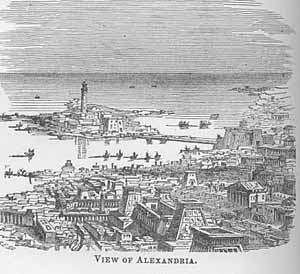 Alexander the Great; As pharaoh;
Alexander the Great; As pharaoh;He gained access to all the treasures of Egypt, including the whereabouts of Hermes’ (Akhenaten's?) tomb. Convinced it was his destiny to reveal the ancient secrets, Alexander immediately headed across the Libyan desert to an ancient temple at Siwa near where the tomb was located. According to Albertus Magnus and others, that is where Alexander found the Emerald Tablet.
Alexander took the tablet and scrolls he found in the tomb to Heliopolis, where he placed the scrolls in the sacred archives and put the Emerald Tablet on public display. Construction of the city of Alexandria to house and study the Hermetic texts was begun immediately, and he assembled a panel of priests and scholars to prepare Greek translations. According to esoteric historian Manly P. Hall, the mysterious Emerald Tablet caused quite a stir. One traveler, who had seen it on display at Heliopolis, wrote: "It is a precious stone, like an emerald, whereon these characters are represented in bas-relief, not engraved. It is esteemed above 2,000 years old. The matter of this emerald had once been in a fluid state like melted glass, and had been cast in a mold, and to this flux the artist had given the hardness of the natural and genuine emerald, by his art."
When Alexander left Egypt, it has been suggested that he took the original tablet with him and hid it for safekeeping before going on to conquer Babylonia and India. Meanwhile, copies of the tablet became primary documents at Alexandria, and according to some reports, scholars issued revised Greek translations in 290 BC, 270 BC, and 50 BC. Several papyrii in the British Museum mention a canon of Egyptian teachings that included the writings of Hermes that was still in existence at the time of Clement of Alexandria (around 170 CE). Fortunately, before Alexandria's libraries were destroyed in successive burnings by the Romans, Christians, and Muslims, copies of the Emerald Tablet had made their way into Arabia and from there eventually reached Spain and Europe.
After Alexander died from a fever on his return from India, his body was interred in a tomb somewhere in the Egyptian desert, although to this day, no one knows where. Yet someone did discover the hiding place of the Emerald Tablet. It is said that a brilliant Syrian youth named Balinas found it hidden in a large cavern just outside his hometown of Tyana in Cappadocia. It was Balinas who absorbed the tablet’s teachings and once again brought them to light in the Western world. The youth became known as Apollonius of Tyana (after Apollo, Greek god of enlightenment and brother of Hermes). Respected for his great wisdom and magical powers, Apollonius traveled throughout the world and eventually settled in Alexandria.
Unfortunately, Apollonius was a contemporary of Christ, and early Christians felt he was much too like their own Son of God. By 400 AD, every one of the scores of books Apollonius wrote in Alexandria and all of the dozens of temples dedicated to him were destroyed by Christian zealots. But Apollonius still stands as the third Hermes in our hyper-history, because he did more than any other person in the modern era to assure that the Emerald Tablet and its principles survived.
Other writings we have found leads us to believe that Ramses II discovered the Emerald Tablets of Thoth and their secret. He secretly worshiped One God. In 1966 an 11 foot tall, double sided statue was found depicting him as himself and Re-Harakhti, the sun god. "Ramses was a preserver and restorer of the Sphinx, and that explains to us the unique form of the statue which shows Ramses as the pharaoh and then with the disk of the sun as the god Re-Harakhti of the Giza Plateau," Ali Hassan, undersecretary of state for archaeology . Just as Akhenaten's monuments were destroyed, the Ramses II's statue was buried to hide his 'One Sun God' belief.
Hermes is always the revealer of ultimate knowledge hidden to mankind. He is like a spirit who reincarnates through time to guide us in our struggle toward enlightenment. It is a tradition that goes all the way back to the first Hermes, the god Thoth, who was said to inspire people with direct perception of truth. "May Thoth write to you daily," utters the 3,500-year-old Papyrus of Ani.
This is from my friend's page; Pharaoh and the aprons were ornate jeweled or heavily embroidered, may have had symbolic meanings, particularly relating to the Union of the Two Lands. They did use the square and the plumb bob, and maybe a kind of 'compass' for drawing circles, etc. In fact there were some found in Tut's tomb, as well as a ruler, or cubit measure rod. (Mason's tools) More information on that may be found at the Griffith Institute/Asmolean Museum in England, where all the originals of Carter's notes and Harry Burton's photos from the excavation are. Karen Odeay. Her site is SunChild, Prince of Egypt
THE Rosicrucian Order
THE Rosicrucian Order had its traditional conception and birth in Egypt in the activities of the Great White Lodge.
{p. 42} In a translation from the original hieroglyphic inscriptions in The Book of the Dead, by Sir E. A. Wallis Budge, we find these admonishments, "to allow no one to see it," nor was it to be recited to even a close friend, for further we find: "never let the ignorant person, or anyone whatsoever look upon it"; also "the things which are done secretly in the hall of the tomb are the mysteries ..."
In some cases, classes of a very select nature were held in the private chambers of the reigning Pharaoh.
The members of such assemblies became more and more select, the teachings more profound, and the discussions so dialectic that there arose a most autocratic and secret society of the truly great minds of the day. Thus was laid the foundation of the Great White Brotherhood.
The first Pharaoh who conducted the class in his private chambers was Ahmose I, who reigned from 1580 B.C. to 1557 B.C. Because he was capable of {p. 43} conducting the great school as well as ruling the people with more civilized and advanced principles (due to his training in the school, no doubt), he is referred to as the "deliverer of Egypt" by some historians.
He was succeeded as Pharaoh by Amenhotep I, who became a teacher in the secret school for three years.
On January 12 (approximately), 1538 B. C., Thutmose I was crowned succeeding Amenhotep I. He owed his position to his wife, Ahmose, who was the first woman to become a member of the class on equal terms with the men. The discussion regarding her admittance (preserved in the Rosicrucian Archives) forms an interesting story and reveals the origin of some of the doctrines of the equality of the sexes.
Thutmose I was succeeded by Hatshepsut, his daughter, who ruled as a "king" independently and as co-regent with her half-brother Thutmose II, a son of Thutmose I by his marriage to Isis.
It was Thutmose III who organized the present physical form followed by the present secret Brotherhood and outlined many of its rules and regulations. He ruled from approximately 1500 B. C. until 1447 B. C., and his reign is unimportant to us except for his establishment of the Brotherhood.
{p. 44] History relates a very strange occurrence, in the life of Thutmose III, that is mystically important to us. We are told of a great feast which, oddly enough, if that is the term to use, occurred about on the occasion of the Spring equinox. This great festival was being held in the Temple of Amen, one of the prevailing gods of the time, in the great Temple of what is now Karnak at Thebes, Egypt, the then great capital city. We can visualize this ceremony, if we will; the magnificent colonnaded halls of this splendid edifice, the balmy air of a March evening in Egypt, the Nile nearby, swaying palm trees, the heavy shadows, the flickering light of the torches, the colorful attire of the priests and the assembly, the chanting, the soft strains of the string instruments.
Thutmose III, as was his custom, was present at the feast. He, with his colleagues, was seated in the Northern Hall of the great Temple. The chief priests or Kheri Hebs were perambulating and carrying a little image symbolic of the god Amen. As they passed the different groups of personages they were acclaimed. But, strangely, the High Priest would walk over to each group and peer into their faces as though he were searching for someone, and then as if realizing that they were not the ones, he {p. 44} would shake his head in the negative, and cross over to the opposite side and repeat the process. He knew all the time that Thutmose III was present, but finally when he reached the Northern Chamber of the Temple, he acted as though he had suddenly discovered the one for whom he had been searching. He placed at the feet of Thutmose III the image of Amen which depicted, in the customs of the time, that he, Thutmose III, had been chosen instead of his brother to succeed the father upon the throne, and the great assemblage broke forth in acclamation.
What interests us mostly, and which is recorded in history, is Thutmose III's explanation of his experience upon the occasion. He had no knowledge that he was to be chosen to become Pharaoh, because by right of accession, his brother should have been. But when the image was placed at his feet, he was seen to stand up; however, according to Thutmose III he felt "raised" as though his feet hardly touched the ground, and as though he had ascended into the heavens, and there he tells us God duly appointed him to serve his people. In fact, he felt as though he had been divinely ordained because of the mystical experience, and it became not even necessary for him to journey to {p. 45} Heliopolis where the Sun Temple was located, as had been the custom, to be formally coronated. *
He appears to have been quite original in his application of the doctrines of mysticism, but held to the existing external form of religion, possibly because of political conditions. Egypt was not free from the danger of the "grasping hand" of adjoining nations and the life of this ruler was constantly tormented by outbreaks of war; the cooperation of his military forces depended considerably upon his permitting the populace to indulge in all its fanciful beliefs - especially the idolatrous religions. For this reason an immediate change in the fundamentals of their religion - such as was made by Thutmose's descendant, Amenhotep IV, in 1355 with such reactionary results - did not seem advisable or even necessary.
A gradual development in the existing mystical beliefs could be more easily and permanently accomplished by establishing a secret school of philosophy, the students of which would put into practice the high standards selected.As in all ages there were those who might be called adtanced thinkers, true philosophers, sages, and scholars. Many of these were students of the * (Breasted, History of Egypt. Chap. XV, p. 268.) {p. 47} mystical doctrines as taught by Thutmose's predecessors, and they evidently had great faith in the final success of the principles; for when Thutmose proposed that the "class" which had been meeting in his chambers become a closed and secret order, "there was no dissenting voice, and articles of limitations were established ere the assembly dispersed in the early hours of dawn."
This grand "Council Meeting," for such it is considered in all official records of the Order, occurred during what would be the week of March 28th to April 4th of 1489 B. C., according to our present calendar. It is generally conceded to have been on Thursday, April 1st, but this may be associated with Maunday Thursday, a later establishment. However, Thursday has become the usual day for Rosicrucian meetings, and "Maunday" Thursday has become the occasion for special Temple Convocations in many AMORC Lodges of the world.
Twelve known Fratres and Sorores were present at this first Supreme Council. The Sorores were the wife of Thutmose III, known in the Order as Mene; the wife of one of the Fratres; and another who was a descendant of one of the rulers of a preceding dynasty. Therefore, there were nine Fratres and three Sorores at this Council, a combination of numbers very significant.
{p. 48} No worldly name was decided upon for the Brotherhood, the records showing that the predominating thought was the maintenance of secrecy.* The organization had no publicity; it required no propaganda other than personal advice to those whose presence was as desired, and as the one word, translated into Brotherhood (a secret, fraternal body), was sufficient name for all purposes, we do not find any other term. This accounts for the widespread diversity of the name as adopted later. In many of the documents issued to the Grand Lodges throughout the entire world, the name of the Order is seldom mentioned.
The idea of secrecy is so strong and predominant that the Order is referred to indirectly and sometimes erroneously (or perhaps diplomatically) as it, the school, the brotherhood, or the council. Furthermore many of these documents begin with the announcement: "1, Brother of the Illuminati, with power decreed, do declare this Manifesto, " or with the Salutation: "I, F. Illuminati of the 12." (I, Frater Illuminati of the 12th degree.) Very often these official manifestoes are signed: "With Peace
{footnote} * It must not be construed that the word Rosicrucian, or any variation of it, was used by, or applied to, this ancient brotherhood. This Egyptian Brotherhood was not Rosicrucian as we know the Order today, but rather the Order has its traditional roots in the ancient brotherhood. It derives its principles and objectives from it. {end footnote}
{p. 49} Profound" and sometimes "F, Profundis" or "F, 12."
These words not only show that the twelfth or last degree has been the last circle within the Order, and known as the Illuminati, even to this day, but they also expiain why some references are made to these documents as "Instructions of the Illuminati," which may easily be misinterpreted as "Instructions to the Illuminati" as one sees them referred to in works published abroad in the 15th, 16th, and 17th centuries A. D., where the Order Rosae Crucis is designated solely by the term Illuminati. more.. Akhenaten
Search this site
Our search Engine does not search for the links in this site, only words in the text.
NO PART OF THIS SITE MAY BE COPIED OR REPRODUCED, IN WHOLE OR IN PART WITHOUT THE EXPRESS WRITTEN APPROVAL OF THE WEBMASTER...© COPYRIGHT 1999 - 2010 c.i.c.ALL RIGHTS RESERVED